Do Satanists have the right to religious freedom, according to Vatican II?
Those who defend Vatican II, and condemn those who object to it, need to own the implications.
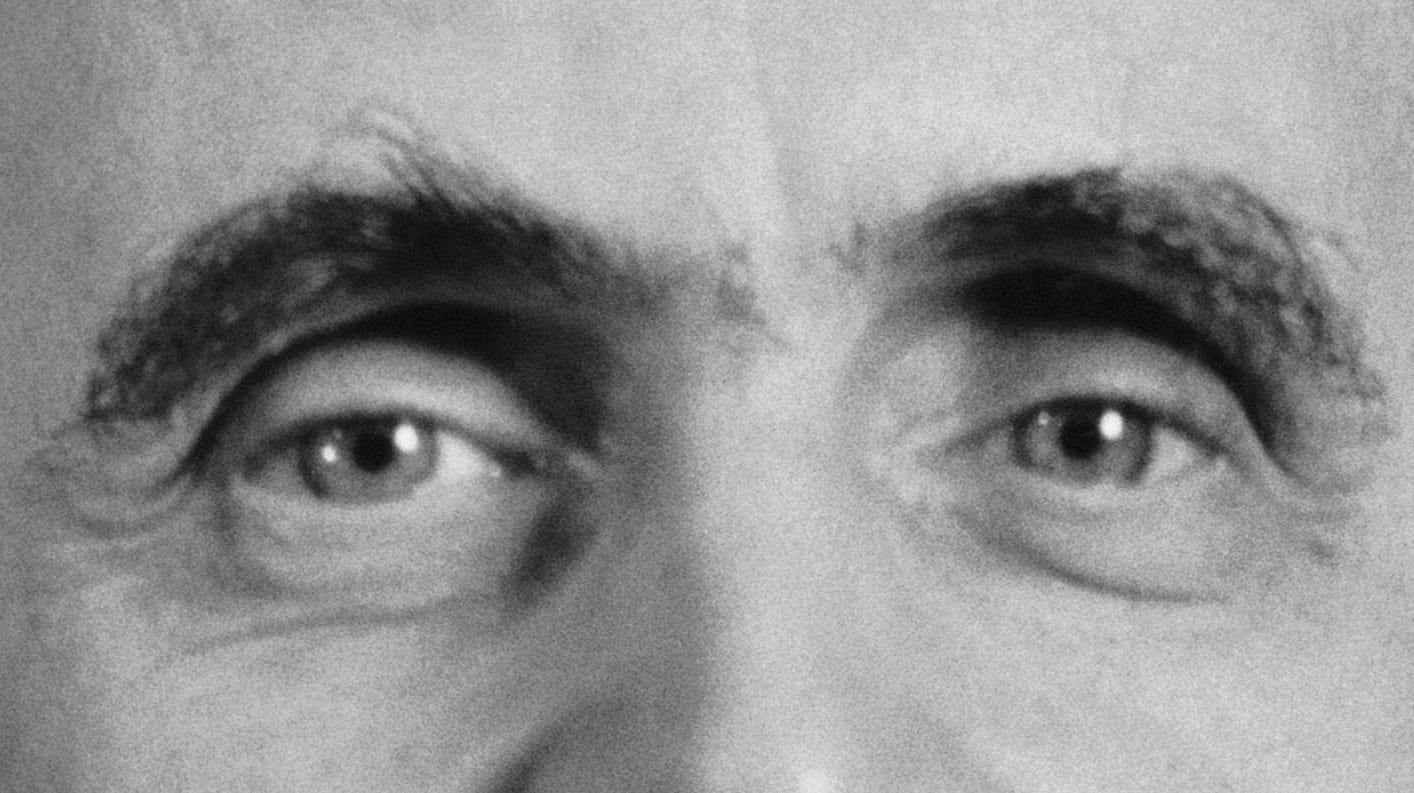
Those who defend Vatican II, and condemn those who object to it, need to own the implications.
Kansas State Capitol Black Mass
A self-styled Satanist allegedly punched a man in the Kansas State Capitol while attempting to “dedicate” it to the devil.
He also allegedly desecrated a host and allegedly assaulted a brave man who rushed to consume it as it fell to the ground.
The idea that Satanists have a right to religious freedom may indeed seem disgusting—but don’t look away: this is the logical consequence of Vatican II’s teaching on religious liberty.
Anyone who defends Vatican II’s Dignitatis Humanae must own what it has unleashed.
The true doctrine of religious tolerance
Prior to Vatican II, the philosophical and doctrinal points were clear.
The Catholic Church is a perfect society, immune from the interference of the state, and absolutely free to exercise her mission
The state had a moral obligation to recognise and worship the true God in the true way—in other words, to uphold and establish the true religion, the Catholic Church.
Equating all religions in law was condemned as impious indifferentism and an offence against God.
False religions had no rights—they could be tolerated for grave reasons, but never recognised or protected as a matter of justice.
Religious freedom was not a natural right for persons either, but a concession could be granted to prevent greater evils, where necessary
Charity and justice to persons was upheld—but intolerance of error was a duty of both Church and state.
These points, taught time and again by the popes and echoed by the theologians. Archbishop Marcel Lefebvre’s Religious Liberty Questioned contains a number of striking examples:
Another subject of sorrow which painfully affects Our heart and, We confess, torments Us with extreme anguish and despondency, is the 22nd article of the [French] constitution. Not only is the liberty of worship and of conscience permitted, but, to use the very words of this article, support and protection are promised to that liberty and to the ministers of those so-called denominations as well.
Pius VIII, Post Tam Diuturnas, 1814.
We now come to another and most fruitful cause of the evils which at present afflict the Church and which We so bitterly deplore; We mean indifferentism, or that fatal opinion everywhere diffused by the craft of the wicked, that men can by the profession of any faith obtain the eternal salvation of their souls, provided their life conforms to justice and probity....
From this poisoned source of indifferentism flows that false and absurd, or rather extravagant, maxim that liberty of conscience should be established and guaranteed to each man.
Gregory XVI, Mirari Vos, 1832.
Incidentally, John Henry Newman said of the above condemnation:
“It seems a light epithet for the Pope to use, when he calls such a doctrine of [liberty of] conscience deliramentum: of all conceivable absurdities it is the wildest and most stupid.”1
The papal teaching continues with the following propositions condemned by Pius IX:
“ ...the best condition of human society is that wherein no duty is recognized by the Government of correcting, by enacted penalties, the violators of the Catholic Religion, except when the maintenance of the public peace requires it.”
“ ...the liberty of conscience and of worship is the peculiar (or inalienable) right of every man. ”
“[This right] must be proclaimed and guaranteed by law in every properly constituted society.”
Pius IX, Quanta Cura, 1864.
Leo XIII condemned the following proposition:
[The State] is bound to grant equal right to every creed, so that public order may not be disturbed by any particular form of religious belief. And it is a part of this theory that all questions that concern religion are to be referred to private judgment; that every one is to be free to follow whatever religion he prefers…
Leo XIII, Immortale Dei, 1885
He also said:
But it would be superfluous to insist on these reflections. On other occasions, in public documents addressed to the Catholic world, We have demonstrated how erroneous is the doctrine of those who, under the seductive name of “liberty of worship,” proclaim the legal apostasy of society from its Divine Author.
Leo XIII, E Giunto, 1889
There are many other such examples. The doctrine is discussed in a systematic way at greater length here:
According to the traditional doctrine, the answer to question is clear: No, Satanists do not have a right to religious freedom, in the sense of having a right to profess blasphemous doctrine and to offer blasphemous rites in public. Neither do any false religious sects. One or more false religious sects may be tolerated at the discretion of the civil authority, when the circumstances require it; but such a decision would be based on the duties of rulers to ensure peace and the common good of civil society, not on the supposed rights of individuals to religious liberty.
The preparatory schemas of Vatican II
The preparatory documents for Vatican II taught the same doctrines. Chapter IX of the draft schema for the ‘Dogmatic Constitution on the Church’ taught:
The mutual distinction and proper harmony between Church and State
The subordination of the temporal order to the supernatural end
The duty of civil society to worship God and to recognise the true religion
The rights and independence of the Church, especially in matters pertaining to salvation
The impossibility of religious indifferentism or state neutrality in religious matters.2
Archbishop Marcel Lefebvre said of this section of the draft schema:
“This document simply set forth the Catholic doctrine on that question, a doctrine wholly applicable in a Catholic nation.”3
However, this draft schema—along with many others—was jettisoned, and ultimately replaced with what we find in Dignitatis Humanae.
But what do we find in this document?
Religious liberty in Vatican II
Vatican II's infamous Dignitatis Humanae claimed, contrary to the teaching of various popes:
“2. This Vatican Council declares that the human person has a right to religious freedom. This freedom means that all men are to be immune from coercion on the part of individuals or of social groups and of any human power, in such wise that no one is to be forced to act in a manner contrary to his own beliefs, whether privately or publicly, whether alone or in association with others...”
But there is a caveat which comes immediately after that ellipsis:
“… within due limits.”
The text continues:
“2. […] The council further declares that the right to religious freedom has its foundation in the very dignity of the human person as this dignity is known through the revealed word of God and by reason itself.
“This right of the human person to religious freedom is to be recognized in the constitutional law whereby society is governed and thus it is to become a civil right.”
As noted, these ideas contradict Catholic teaching. But this is not the point at present. Let’s continue with the text
“2. […] The exercise of this right is not to be impeded, provided that just public order be observed."
“3. […] Injury therefore is done to the human person and to the very order established by God for human life, if the free exercise of religion is denied in society, provided just public order is observed.”
“4. […] Provided the just demands of public order are observed, religious communities rightfully claim freedom in order that they may govern themselves according to their own norms, honor the Supreme Being in public worship, assist their members in the practice of the religious life, strengthen them by instruction, and promote institutions in which they may join together for the purpose of ordering their own lives in accordance with their religious principles.”
Conservative defenders of Dignitatis Humanae may point to phrases such as the following:
“1. […] Therefore [This Vatican Council] leaves untouched traditional Catholic doctrine on the moral duty of men and societies toward the true religion and toward the one Church of Christ.”
“3. […] it would clearly transgress the limits set to its power, were it to presume to command or inhibit acts that are religious.”
But we must be clear.
These texts tacitly abandon the Church’s teaching on…
Her own immunity from interference by the civil power;
Her sovereignty in her sphere and exercise of her mission
The duty of the state to recognise and establish the true religion and worship the true God
The duty of civil society to conform its laws to the law of the Gospel
The right of civil society itself, corresponding to the above duties, to suppress false worship—and the duty to do so, providing no other circumstances render it impossible or impractical
The kingship of Christ over all societies.
All these ideas are tacitly abandoned, at least in practice or by implication. While there have been many far-fetched attempts to explain or reconcile the Vatican II doctrine with the traditional doctrine, they can only do so either by retreating into fantastic unreality, or also tacitly abandoning these points.
In effect, the liberty of the Church—which English law enshrined as the first principle of Magna Carta; for which St Thomas Becket, along with Ss Thomas More, John Fisher and the Cristeros all died; which was taught by the popes; and which is a certain doctrine of the faith—this liberty of the Church is abandoned for a mess of pottage: the liberty of religions in general.
One cannot claim, after such statements, that the Catholic Church has a special right to determine such limits: first, this is closing the door after the horse has bolted; next, the Vatican has indeed indicated how these limits should be drawn, in its encouragement for the secularisation of the Italian constitution and other such documents.
Once this exchange has taken place, and the Church’s activity is conceded to be subject to “just limits of public order” along with that of all other religions, who do we seriously think is going to judge what the “just limits of public order” are?
Who exactly is going to judge what the limits of just public order require in a concrete event, except politicians and policemen?
To whom else, but such parties as these has the Vatican abandoned such judgments in the last sixty years?
The lockdowns and the liberty of the Church
Consider the situation in the years 2020-22, when at various times the civil authorities of the world lumped the Church of Christ together with all the false sects, and claimed the right and power to limit her activity along with theirs.
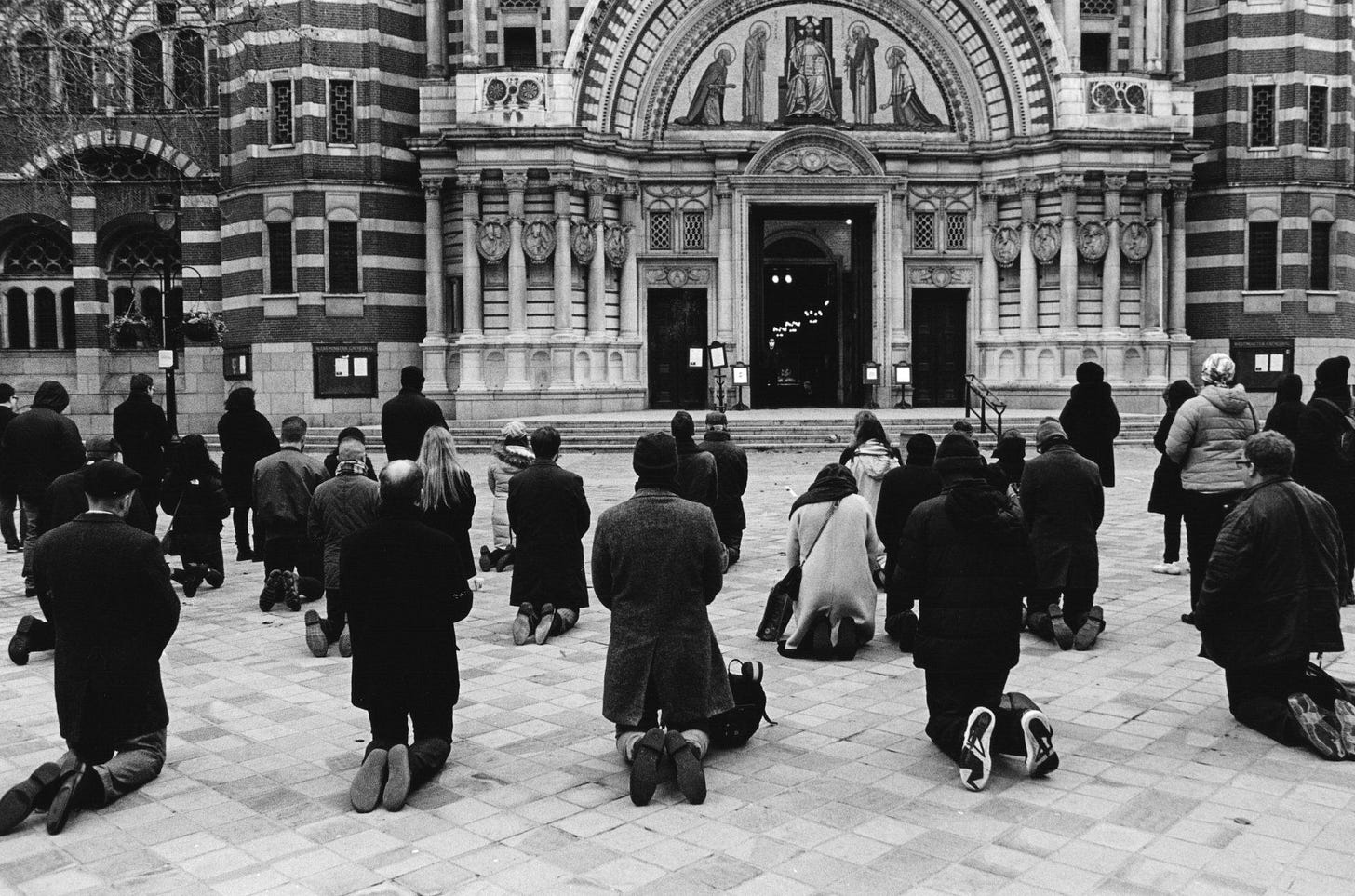
For example, on 23 March 2020, UK Prime Minister Boris Johnson made the following remarks during his statement announcing the coronavirus lockdown:
To ensure compliance with the Government’s instruction to stay at home, we will immediately:
close all shops selling non-essential goods, including clothing and electronic stores and other premises including libraries, playgrounds and outdoor gyms, and places of worship;
we will stop all gatherings of more than two people in public – excluding people you live with;
and we’ll stop all social events, including weddings, baptisms and other ceremonies, but excluding funerals.
The response of the alleged diocesan bishops and the Catholic Bishops Conference of England and Wales (CBCEW) of the United Kingdom was a shocking acquiescence.
It is one thing to obey an unjust law under protest. It is another thing to consent to it.
Similarly it is one thing for the Church herself to suspend her own public worship. It is another thing for the state to do so.
It is yet another thing for the Church to meet this interference with silence, or with protests that are so inadequate as to be, in fact, concessions of the basic principle. For example, the various public statements of Cardinal Nichols and Archbishop McMahon (President and Vice-President of the CBCEW) were worse than silence, as they accepted principles that contradicted the doctrine of the liberty of the Church. For example:
They argued that “Faith communities have played a vital role” in this period4—and thus allowed the Church of Christ to be “placed ignominiously on the same level” with false religions (Pius XI – Encyclical Quas Primas 24)
They asked the Government to provide “evidence that justifies the cessation of acts of public worship”—and in asking for this evidence without protest, they thus implicitly conceded the civil authority’s right to legislate such matters
Bishop Philip Egan of Portsmouth Diocese, England, wrote a letter to the Prime Minister, asking that services be allowed to continue—and while his letter includes some Catholic elements, it was ultimately also a request, based on man’s need for spiritual things and the nourishment from God5
Bishop Mark Davies of Shrewsbury Diocese, England, gave a statement to his own flock, talking of “the vital role which public worship has for the well-being of hundreds of thousands of people in this Shrewsbury Diocese.” He emphasised how public worship is the source of “support for the most vulnerable and countless charitable activities in the service of the common good”—and grouped the Sacrifice of the Mass “together with faith communities across the nation”.6
Examples of such concessions could be multiplied, and they occurred across the whole world.
This period also saw many die without the possibility of the sacraments, due to priests being barred or obstructed from visiting the dying in hospital and at home. The coronavirus period was very strange for everyone, but it was still possible to express at least verbal dissent and to profess the relevant principles without being killed or imprisoned.
As such, the maxim silence implies consent definitely applied, especially as time went on.
Thankfully, while it was the responsibility of the alleged diocesan bishops to speak out against this travesty, some bishops and priests still had a sense of the supernatural during this period, and were willing to risk themselves for the glory of God and the salvation of souls—for our gratitude is most certainly due.
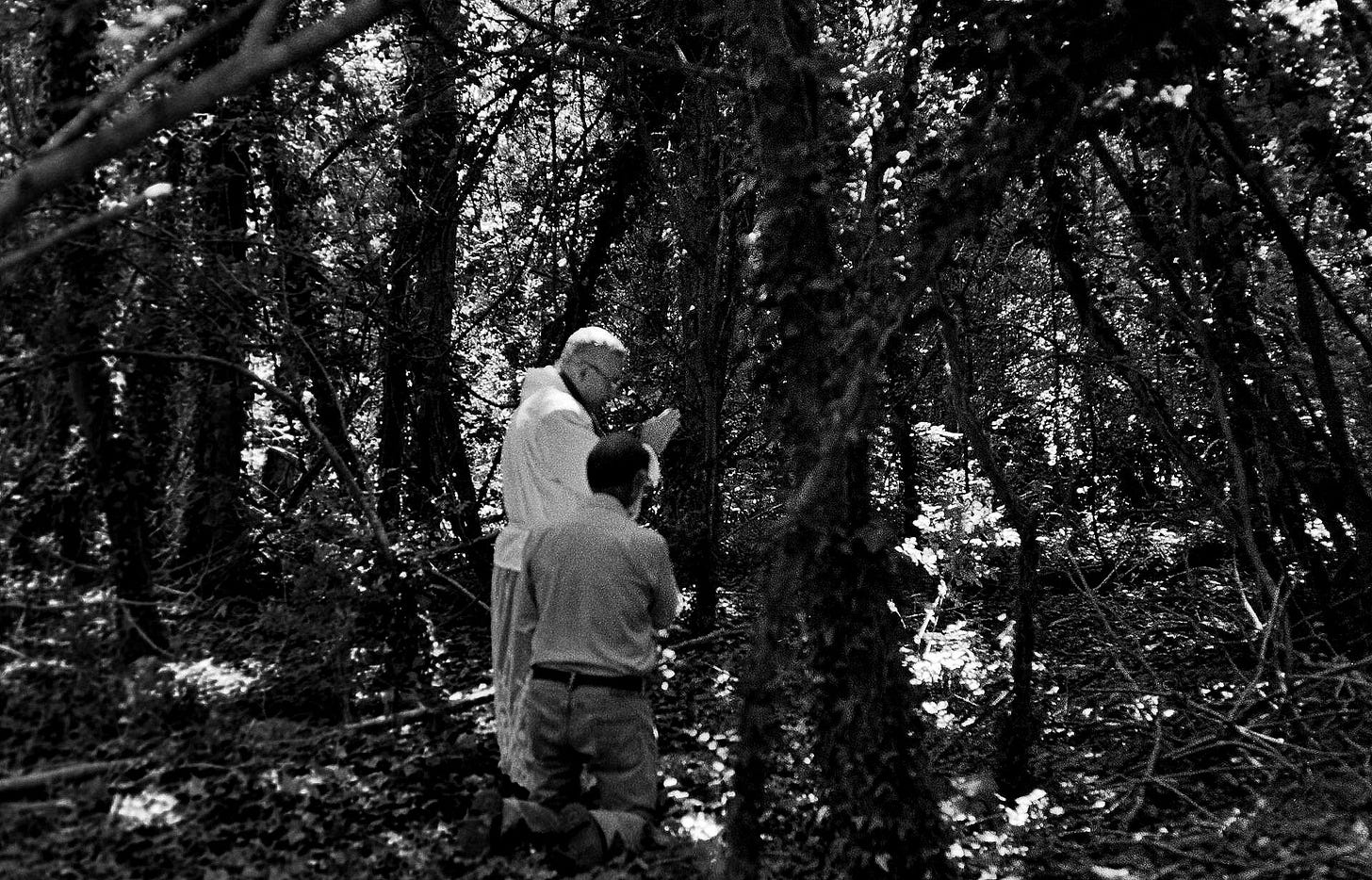
Last rites—the last priority
Consider also the tragic case of the late Catholic politician Sir David Amess MP, who was murdered in 2021 by Ali Harbi Ali, in Leigh-on-Sea, Essex.
Fr Jeffrey Woolnough, a priest of the Anglican Ordinariate, arrived on the scene to administer the last rites. Woolnough said at the time:
“I told one police officer ‘if he is dying, I need to anoint him,’” said Woolnough, recounting that the same police officer did in fact radio his team to ask whether the priest could be allowed in, and waited for a reply which unfortunately came back negative: “I’m really sorry Father, but they can’t let you in,” the police officer said.
Woolnough speculated that the police may have had safety concerns for him in the midst of an ongoing terrorist attack, or that Amess was already dead and that forensics teams were already present when the request was made.
In a society built on naturalism, it is entirely predictable that the supernatural will be treated as optional, non-essential and something which can be accommodated as the last possible priority.
It is no good saying that politicians or policemen are unjust, inhumane or wrong for all this if one has already conceded that the Church’s life and mission are subject to the limits of just public order.
Those limits will necessarily be decided by politicians in principle and policemen in practice.
Some objections
Worship of the true God? It is objected that “Dignitatis Humanae speaks of a right to worship the Numen supremum, i.e. God”—and that this does not pertain to the devil-worship and blasphemy in Kansas (or elsewhere).
But would this defence imply that the worship of some gods in polytheistic religions is acceptable, while others should be forbidden? Is Jupiter or Odin to be permitted—on the grounds that some conservative Catholics see them as distorted echoes of the true God—while Mars or Thor are excluded? What of the Hindu pantheon?
Are we really to understand Vatican II as prohibiting polytheism, and yet permitting false monotheism? What kind of a defence is that?
And what of the Scriptural maxim, that “all the gods of the gentiles are devils”?The claim that Dignitatis Humanae refers exclusively to the true God is utterly detached from reality.
In any case, Dignitatis Humanae states that the supposed right to religious freedom is granted to all men, and that it involves a right not to be coerced or forced to act “in a manner contrary to his own beliefs”:
2. This Vatican Council declares that the human person has a right to religious freedom. This freedom means that all men are to be immune from coercion on the part of individuals or of social groups and of any human power, in such wise that no one is to be forced to act in a manner contrary to his own beliefs, whether privately or publicly, whether alone or in association with others, within due limits.
The council further declares that the right to religious freedom has its foundation in the very dignity of the human person as this dignity is known through the revealed word of God and by reason itself. This right of the human person to religious freedom is to be recognized in the constitutional law whereby society is governed and thus it is to become a civil right.
The comment “within due limits” cannot credibly be taken to mean “providing all this is in reference to the true God.”
Further, once the document says that this right is to be enshrined in civil law and protected by civil society, Catholics have no authority to define what qualifies as a religion.
Presumed helplessness of the Church: It is also claimed that the Church cannot dictate to the civil power what can and cannot be tolerated. But this is beside the point: Vatican II abandons the relevant principle, and asserts that each person has a right, rooted in divine revelation, not to be coerced in religious matters.
The Church determines “just public order”: Others have claimed that these texts presume that the Church and Christian morality remain normative in deciding what are the limits of “just public order.” It is true that the document claims that “The freedom of the Church is the fundamental principle in what concerns the relations between the Church and governments and the whole civil order.” (n. 13). But the same applies: once these concessions have been made, it is not for the Church to be defining what does and does not constitute just public order.
Orthodox texts: It is also alleged that other documents in Vatican II call for the laity to “infuse a Christian spirit into the temporal order” (Apostolicam Actuositatem n. 19). But this is of no use either. First, the “Christian spirit” in Vatican II is one which holds that its doctrine of religious freedom is based on divine revelation. Next, even if we overlook this, “orthodox” phrases from Vatican II do not help its defenders, as we are not weighing its statements in scales, or engaging in a game of hermeneutics. Pope St Pius X, and other popes, explicitly warned Catholics about those who speak in an orthodox way in one place, and a heterodox place in another. Such appeals require a naivety which sixty years do not permit.
Conclusion—the point stands
In any case, even these far-fetched defences of the Vatican II doctrine—claiming that they do not extend religious freedom to Satanists—leave an utterly unreal interpretation, which still entails what Pope Leo XIII called "the legal apostasy of society from its Divine Author."
This is precisely what Pope Pius XI warned about in his encyclical Quas Primas. This encyclical was on the Kingship of Christ, and it should be clear that this “social reign of Christ the King” is in many ways equivalent to the liberty of the Church.
In this encyclical, Pius XI noted the following trajectory towards ruin:
The rejection of Christ’s Kingship itself, “the empire of Christ over all nations,” which leads to…
The rejection of the liberty of the Church, “the right which the Church has from Christ himself, to teach mankind, to make laws, to govern peoples in all that pertains to their eternal salvation,” which leads to…
The imposition of religious liberty and indifferentism, namely, the process by which “the religion of Christ came to be likened to false religions and to be placed ignominiously on the same level with them,” which leads to…
The subjection of the Church to “the power of the state [leaving her] tolerated more or less at the whim of princes and rulers,” which leads to…
The promotion of naturalism, “a natural religion consisting in some instinctive affection of the heart”. Which ultimately leads to…
Atheism and atheistic states, which hold that they “could dispense with God, and that their religion should consist in impiety and the neglect of God.”
This is why, for example, St Thomas Becket cannot possibly be said to have died for religious liberty.
When the liberty of the Church and Christ’s Kingship over society are abandoned, it should not be surprising that the State encroaches into the power vacuum which appears. If those purporting to be our shepherds do not defend the immunity and liberty of the Church, we cannot be surprised to find that the state subjects her to its power, interferes with her life and even suppresses her altogether.
For this reason, we should be clear.
Satanists desecrating the hosts in a manner construed as “peaceful” by the civil authorities
Churches closed due to a health crisis
Grandparents and parents dying alone, surrounded by strangers and without a priest
Policemen preventing us from receiving the last rites after having been fatally stabbed
… and who knows what else:
Together, these abominations constitute the true face of Vatican II and its false doctrine of religious liberty.
Let those who want to defend Vatican II or attack those who reject it look that reality squarely in the face.
Read next:
See also: Religious Liberty – The Failed Attempts To Defend Vatican II
HELP KEEP THE WM REVIEW ONLINE!
As we expand The WM Review we would like to keep providing free articles for everyone.
Our work takes a lot of time and effort to produce. If you have benefitted from it please do consider supporting us financially.
A subscription from you helps ensure that we can keep writing and sharing free material for all. Plus, you will get access to our exclusive members-only material.
(We make our members-only material freely available to clergy, priests and seminarians upon request. Please subscribe and reply to the email if this applies to you.)
Subscribe now to make sure you always receive our material. Thank you!
Follow on Twitter, YouTube and Telegram:
John Henry Newman, Letter to the Duke of Norfolk, 1875, p 275. Published in Certain Difficulties felt by Anglicans in Catholic Teaching Considered, Vol. II. Longmans, Green, and Co., London, 1900. Available at https://www.newmanreader.org/works/anglicans/volume2/gladstone/section5.html
They Have Uncrowned Him, Chapter XXVIII
https://www.cbcew.org.uk/wp-content/uploads/sites/3/2020/11/faith-leaders-letter-pm-places-worship-covid-secure-031120.pdf
https://www.portsmouthdiocese.org.uk/coronavirus
https://icksp.org.uk/shrewsbury/second-lockdown-a-statement-from-the-rt-rev-mark-davies-the-bishop-of-shrewsbury/




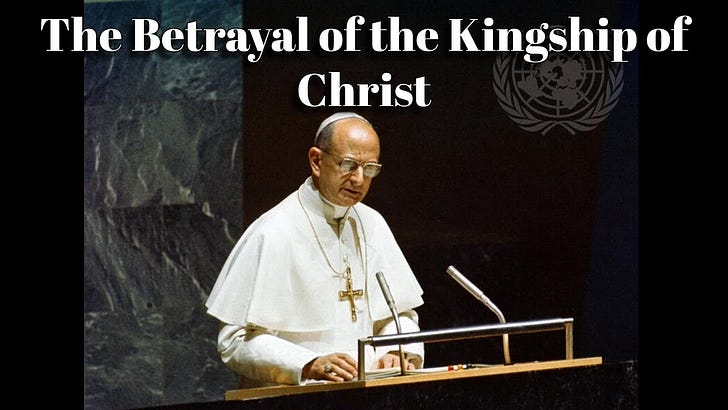
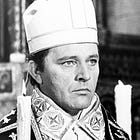
This is such an important discussion. People too often downplay the consequences of this new approach to other religions. Thank you!
The maxim false in one, false in all applies to Vatican II and the man who promulgated such falsehood.